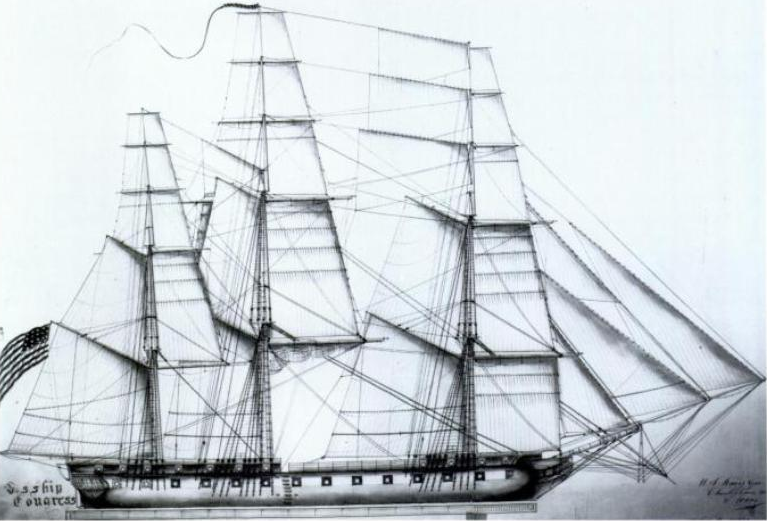He opened his master’s door to a redcoat the night before the Boston Massacre and heard that soldier offer a warning to Thayer to keep safe off the streets for the next couple of days.
I wondered what happened to Asa Copeland in subsequent years. One of my interests is how the children of Boston were shaped by the political turmoil of the ten years before the war.
Tracking this Asa Copeland isn’t certain because there were other youths of that name. One was born in Braintree in 1756, son of Seth and Lydia Copeland, neighbors of John and Abigail Adams; that lad would have been a good candidate to be Amos Thayer’s apprentice in 1770 since Thayer was also from Braintree. But that Asa Copeland remained in Braintree after the war, long enough to apply for a pension.
Instead, I think the Asa Copeland who became an apprentice carpenter in Boston was the man described by descendants in volume IV of Genealogical and Memorial History of the State of New Jersey, edited by Francis Bazley Lee and published in 1910. That entry is based on a blend of family tradition and research in genealogical sources available at the time.
The descendants were certain this Asa was the son of Jacob and Abigail Copeland, who hailed from Braintree but were living in Boston when they had him. But they didn’t know when he was born. The profile describes Asa as “at the age of seventeen” during the Tea Party of late 1773 and “about nineteen” at the start of 1777, which doesn’t add up. Descendants understood that Asa was “present at the ‘Boston Tea Party’” (which this book misdates). He may well have been present; hundreds of Bostonians were, watching but not participating.
That profile gets on more solid ground when it discusses Copeland’s military service. In January 1777, Copeland joined Maj. Ebenezer Stevens’s artillery battalion of the Continental Army. Like Copeland’s master, Stevens had been a carpenter in Boston before the war. The artillery needed skilled craftsmen. Soon Asa Copeland was a sergeant, and then a sergeant-major.
In April 1779, Copeland was appointed a conductor of military stores, caring for the army’s weapons. Thus, in 1781 Gen. Henry Knox sent him instructions “to procure 1500 muskets, 3 tons of lead, and all of the pistols at New Windsor” and to send some stores to Philadelphia.
In September 1782, as the army wound down, Gen. Knox listed Copeland among the personnel “proper to compose the department of field commissary” in a letter to Gen. George Washington. Copeland reportedly produced “a survey or inventory of ordnance at West Point, New York, dated April 20, 1783” for Knox.
After the war, Copeland settled in Philadelphia rather than returning to Massachusetts. On 27 Feb 1783 the Rev. William White married Copeland to Amelia Price. Eventually the couple had eight children, four girls and four boys. The veteran appears to have gone into business trading goods, using the skills and contacts he developed during the war.
In the 30 Aug 1793 Pennsylvania Gazette Copeland advertised “the schooner Milley” for charter to the West Indies. In October 1794 the U.S. of A. was undertaking to build frigates, including the Constitution. Revenue commissioner Tench Coxe wrote to Knox, then Secretary of War:
in pursuance of the Idea entertained by you and my self in a late conference, I have engaged Mr. Asa Copeland a trader in this town, To go to Georgia for the purpose of assisting Mr. J. T Morgan in expediting the hauling &c. of Timber & dispatching the Vessels.The country needed strong live oak for the frigates. Coxe told his boss Alexander Hamilton, “Mr. Asa Copeland…is expected to be very useful. He has been accustomed to the Coasting trade and to the procuring of ship Timber.” (But Coxe also had to tell Knox that Copeland, not being a shipwright, couldn’t simply take over Morgan’s job.) According to a Navy Department report at the end of 1794, Copeland’s pay was “three and one-third dollars per day.”
Asa Copeland completed that job for the federal government and returned to Philadelphia, but unfortunately he died on 23 Sept 1797. His family understood the cause to be yellow fever, even though the city’s big epidemic had occurred four years before. The Copelands’ last child was born the following month and died within a year.
So far as I know, we have no personal or political statements from Asa Copeland that preserve his thoughts about the Massacre, the Tea Party, and other events from his teen years in Boston. But it’s clear he committed years to the Continental Army and the United States, and that service gave him the standing to build a new life as a businessman in America’s capital city.

No comments:
Post a Comment